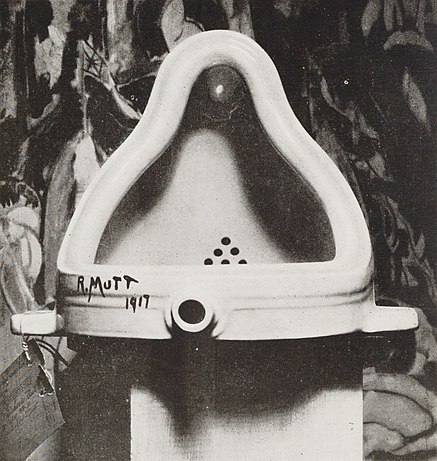I was the only person at that school that really seemed to be able to draw well. Not a bad thing in my book, but it didn't help me one bit in trying to get at the heart of conceptual art. All of the pieces were too literal. Really, I didn't, and still don't get it, in terms of how to even approach it - not that I am trying to beyond having 'a concept', and 'idea' in each painting.
What am I talking about in each painting? I was warned by my landscape instructor at CCAD against making paintings that people wanted to hang over their sofa, and I never chose a subject just because I think it will sell. But, I do think with the start of each painting, what am I trying to say?
Still, conceptual art seems to keep coming up in conversations lately. And I would like to understand it. So, I Googled 'conceptual art'.
The first thing that came up was Wikipedia, of course; the first photo was of "Fountain" by Marcel Duchamp, and I was reminded how much I love his work.
 |
| Marcel Duchamp, Fountain, 1917. Photograph by Alfred Steiglitz |
I thought I'd also post this conceptual piece, which I love probably because I've felt the power of fabric hanging in the landscape in Bhutan. How beautiful and impressive this must have been in it's short lifetime.
Valley Curtain
"At the end of 1970 Christo and Jeanne-Claude began the preparations for the Valley Curtain project. A 400-meter long cloth was to be stretched across Rifle Gap, a valley in the Rocky Mountains near Rifle, Colorado. The project required 14,000 m2 of cloth to be hung on four steel cables, fastened with iron bars fixed in concrete on each slope, and 200 tons of concrete. The budget increased to $400,000 causing Christo and Jeanne-Claude additional problems with the financing. Finally enough works of art were sold to raise the money and, on 10 October 1971, the orange-coloured curtain was ready for hanging, but was torn to shreds by wind and rock. While a second curtain was being manufactured, Christo received a message from a Berlin art historian to wrap the Reichstag in response to the 1961 "Project for Wrapping a Public Building". On 10 August 1972 the second attempt to hang the cloth succeeded, but only 28 hours later it was destroyed by a storm gale in excess of 60 miles per hour.
The project was shown in the documentary film, Christo's Valley Curtain by David and Albert Maysles, which was nominated for an Academy Award for Best Documentary Short."

And I am reminded now of the power of Sid Chafetz's powerful exhibition "The Perpetrators", lithographs portraits of infamous and powerful Nazis, along with an installation simulating a walk into a Nazi death chamber. I met Sid, once or twice, and know at least one of his students, Edie Dean. Sid passed away last month, but he lives on in his students and in his art. Now that is a concept I like!
I am wondering how many of you look at conceptual art, understand it, can give your insight or experience about it or with it.







No comments:
Post a Comment